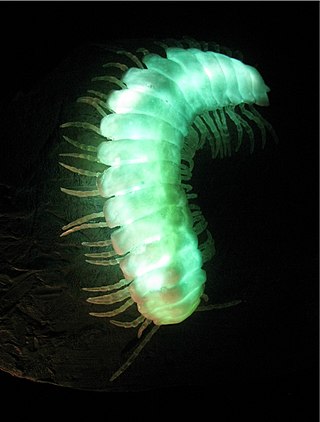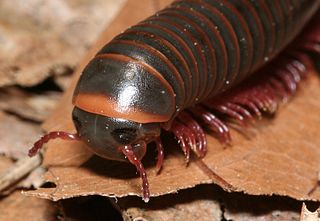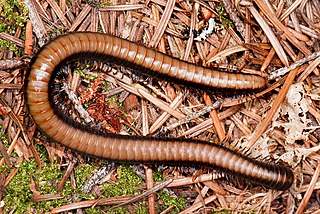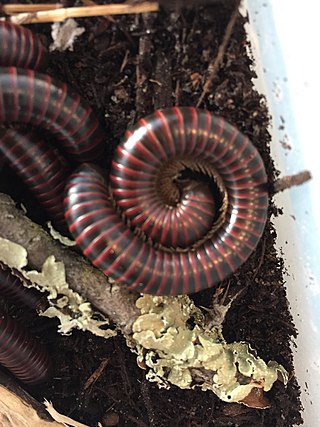
Uropygi is an arachnid order comprising invertebrates commonly known as whip scorpions or vinegaroons. They are often called uropygids. The name "whip scorpion" refers to their resemblance to true scorpions and possession of a whiplike tail, and "vinegaroon" refers to their ability when attacked to discharge an offensive, vinegar-smelling liquid, which contains acetic acid. The order may also be called Thelyphonida. Both names, Uropygi and Thelyphonida, may be used either in a narrow sense for the order of whip scorpions, or in a broad sense which includes the order Schizomida.

Trichopetalum whitei, common name Luray Caverns blind cave millipede, is a rare troglobitic millipede of the upper Potomac River drainage in four Virginia counties and three West Virginia counties. It has been recorded from 12 caves across this range, including the Luray Caverns where it was first discovered and described.

William Tinsley Keeton was an American zoologist known internationally for his work on animal behavior, especially bird migration, and for his work on millipede taxonomy. He was a well-liked professor of biology at Cornell University in Ithaca, New York and author of a widely used introductory textbook, Biological Science.

Xystodesmidae is a family of millipedes. Its members often have very small distributional areas, with many species only known from a single locality. They are found across the northern hemisphere, with peak diversity in the Appalachian Mountains, where one-third of the 300 or so species occur. They are particularly abundant in deciduous broadleaf forests in the Mediterranean Basin, Africa, Asia, Central and North America, and Russia. Information on basic taxonomy is scant for this family; for example, it is estimated that the genus Nannaria contains over 200 species, but only 25 were described as of 2006. By 2022, 78 species in Nannaria have been described.

Motyxia is a genus of cyanide-producing millipedes that are endemic to the southern Sierra Nevada, Tehachapi, and Santa Monica mountain ranges of California. Motyxias are blind and produce the poison cyanide, like all members of the Polydesmida. All species have the ability to glow brightly: some of the few known instances of bioluminescence in millipedes.
Crurifarcimen is a monotypic genus of millipedes containing the single species Crurifarcimen vagans. Its common name is wandering leg sausage. This millipede is endemic to Tanzania, where it is known only from the Usambara Mountains. It was formally described in 2011 and placed in a newly erected genus of its own. It was declared one of the world's top 10 new species of 2012 by Arizona State University's International Institute for Species Exploration.

Richard Lawrence Hoffman was an American zoologist known as an international expert on millipedes, and a leading authority on the natural history of Virginia and the Appalachian Mountains. He was a biology professor at Virginia's Radford College for almost thirty years, and curator of invertebrates at the Virginia Museum of Natural History for another twenty years. He co-founded the Virginia Natural History Society, described over 400 species of millipedes, and produced more than 480 scientific publications. He is commemorated in the scientific and/or common names of over 30 animal species, including the valley and ridge salamander and Hoffman's dwarf centipede.

Xyloiuloidea is an extinct superfamily of millipedes that existed from the Lower Devonian through the Upper Pennsylvanian period in Europe and North America.

Narceus is a genus of large cylindrical millipedes of the family Spirobolidae native to eastern North America. The genus comprises three or four species, two of which are endemic to Florida, and the remainder forming a species complex. The species of Narceus include some of the largest and most recognizable millipedes in eastern North America.

Tylobolus is a genus of millipedes in the order Spirobolida with seven known species found in western North America. It is in the family Spirobolidae, and is the type genus of the subfamily Tylobolinae. The genus was named by Orator F. Cook in 1904.
Hiltonius is a genus of cylindrical millipedes in the family Spirobolidae comprising 10 species ranging from the southwestern United States to Guatemala, with most species being found in Mexico. The genus was named by Ralph Vary Chamberlin in 1918, after Professor William A. Hilton of Pomona College who collected the type specimen of H. pulchrus.

Harold Frederick Loomis was an American botanist and myriapodologist known for his contributions to agronomy, plant pathology, and millipede taxonomy. He worked for the U.S. Department of Agriculture for over four decades, studying diseases of crop plants, and was a colleague of Orator F. Cook. He also made major contributions to the natural history of Central America and the West Indies, naming over 500 species of millipedes in total. He co-described with Cook the leggiest animal on earth: Illacme plenipes, with over 700 legs.

Paeromopodidae is a family of large cylindrical millipedes of the order Julida native to the western United States of America. The family contains two genera and ten species and includes the longest millipedes in North America, with individuals reaching up to 16.5 cm (6.5 in) long.

Paeromopus is a genus of large cylindrical millipedes endemic to the U.S. state of California. All species exceed 10 centimeters in length, and the largest, P. paniculus, reaching 16.5 cm is the longest millipede species in North America. The genus was named by German entomologist Ferdinand Karsch in 1881 and contains four species: three occupying small ranges in the Sierra Nevada mountains and one occupying a large range including the Sierra Nevada and much of Northern California to the Central Coast.

Xystocheir is a genus of millipedes in the family Xystodesmidae. The genus is endemic to California in the United States, where it is distributed in the Coast Ranges and the Sierra Nevada.

Narceus gordanus is a spirobolid millipede native to the southeastern United States. Common names include Smokey Oak Millipede and Smokey Ghost Millipede. Adults range from around 60 to 120 mm in length, up to 13 mm wide, and possess 45 to 65 body segments. The body color is lighter than other species of Narceus, with each body ring a light greenish tan followed by a band of darker tan. N. gordanus also has shorter legs than other Narceus species, and a deeper groove on the head in which the antennae rest.

Chicobolus spinigerus, commonly known as the ivory millipede or Florida ivory millipede, is a millipede species native to the southeastern United States, occurring throughout the Florida Peninsula and Panhandle, as well as southern Alabama, Georgia, and South Carolina. Males normally range from 40 to 85 mm long, females up to 90 mm (3.5 in).
Hiltonius pulchrus is a species of millipede in the family Spirobolidae, endemic to the United States. It occurs in California from Kern County to San Diego County.
Narceus woodruffi is a species of millipede endemic to Florida. Described in 1959, it is the smallest species of the genus Narceus, with adults measuring up to 50 mm in length and 4 mm in width.

Tylobolus castaneus is a species of millipede in the family Spirobolidae. It is found in Northern California, typically between Fresno and Contra Costa.
















